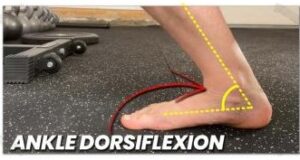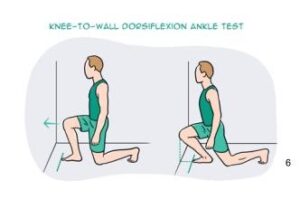The Importance of Ankle Dorsiflexion
There has been a lot of talk in the past several years about if it is “safe” for your knees to go over your toes in functional activities such as squatting or lunging. The motion of your knees going over your toes is known as closed-chain ankle dorsiflexion. Let’s define this:

Closed-chain: when the extremity (in this case, your foot) is fixed to the ground and is not moving.
Ankle dorsiflexion: when your shin gets closer to your toes (think – toes to your nose, lunge, or squat)
Why Is It Important?
- Less ankle dorsiflexion has been shown to increase ground reaction forces, increased knee valgus (knee collapsing inward), and limited ability for the knee to travel over the toes with landing mechanics. All of these are injury risk factors for an ACL tear and, therefore, a lack of ankle dorsiflexion range of motion may be associated with a greater risk of ACL injury. (2)
- Another study shows that reduced ankle dorsiflexion increases the risk of patellar tendinopathies such as patellar tendonitis in volleyball players. (3)
- Lack of ankle dorsiflexion has also been shown to increase the risk of Achilles tendon pain and tendinopathy in individuals doing rigorous workouts and activities. (4)
So…Should Your Knees Go Over Your Toes?
- YES – it is safe to argue that your knees have to go over your toes to prevent overloading other joints and tissues.
- Studies show there is a minimum amount of closed chain dorsiflexion that helps prevent increased stress at other joints and tissues.
How do I know if I have enough ankle dorsiflexion?
Try this quick screen at home!
- Get into a half kneeling position (as seen below).
- Measure one hand’s width (including thumb) from the wall to your longest toe.
- Drive your knee over your toes and it SHOULD be able to touch the wall.

What Do I Do if I Don’t Have Enough?
Come visit us at Elite Sports Performance and Physical Therapy, where one of our licensed Physical Therapists will be able to determine if your lack of mobility is due to the joint not moving well or tight muscles. This will help reduce your risk for future injury and get you doing what you love with improved efficiency, performance, and reduced risk of injury!
If you or a loved one are dealing with a nagging sports injury, pain, or are in need of post-operative rehab, we can help! With convenient locations in Stoughton & Foxborough, Elite has a team of highly trained Physical Therapists who will work with you to decrease your pain, improve your strength, mobility and function, and get you back to enjoying your favorite activities and an active lifestyle. To schedule an appointment with one of our PTs, visit HERE for more details!

References
- Wittstrom J. Why You Have Ankle Pain When Squatting (And How To Fix It). Strength Resurgence. Published October 23, 2022. Accessed December 27, 2023. https://www.strengthresurgence.com/ankle-pain-when-squatting/
- Fong CM, Blackburn JT, Norcross MF, McGrath M, Padua DA. Ankle-Dorsiflexion Range of Motion and Landing Biomechanics. Journal of Athletic Training. 2011;46(1):5-10. doi:https://doi.org/10.4085/1062-6050-46.1.5
- Malliaras P, Cook JL, Kent P. Reduced ankle dorsiflexion range may increase the risk of patellar tendon injury among volleyball players. Journal of Science and Medicine in Sport. 2006;9(4):304-309. doi:https://doi.org/10.1016/j.jsams.2006.03.015
- Rabin A, Kozol Z, Finestone AS. Limited ankle dorsiflexion increases the risk for mid-portion Achilles tendinopathy in infantry recruits: a prospective cohort study. Journal of Foot and Ankle Research. 2014;7(1). doi:https://doi.org/10.1186/s13047-014-0048-3
- Weight Bearing Lunge Test | Ankle Passive Range of Motion. Physiotutors. https://www.physiotutors.com/wiki/weight-bearing-lunge-test/
- Carreon J. Knee to Wall test. Washington Athletic Club. Published January 17, 2022. https://www.wac.net/wac-wire/knee-to-wall-test/
